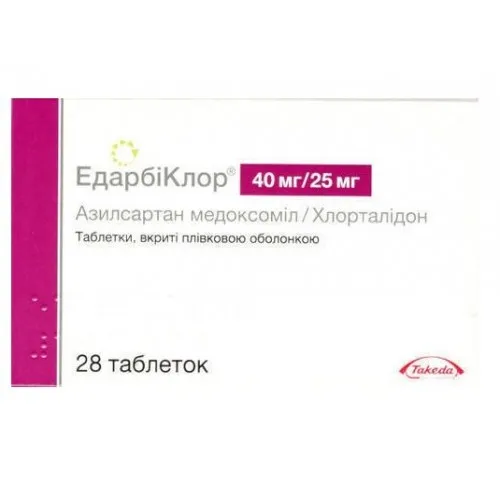Description
Edarbiclor (Azilsartan Medoxomil, Chlorthalidone) Coated Tablets 40 mg/25 mg. №28
Ingredients:
Each coated tablet contains 40 mg of azilsartan medoxomil and 25 mg of chlorthalidone.
Mechanism of Action:
Edarbiclor tablets combine azilsartan medoxomil, an angiotensin II receptor blocker (ARB), with chlorthalidone, a diuretic. Azilsartan medoxomil relaxes blood vessels, while chlorthalidone helps the body eliminate excess salt and water, resulting in lowered blood pressure.
Pharmacological Properties:
The dual action of azilsartan medoxomil and chlorthalidone in Edarbiclor tablets synergistically reduces blood pressure by targeting different physiological pathways involved in hypertension regulation.
Indications for Use:
Edarbiclor tablets are indicated for the treatment of hypertension to effectively lower blood pressure levels and reduce the risk of associated cardiovascular complications.
Contraindications:
Avoid using Edarbiclor if you have a known allergy to any of the ingredients, are pregnant, or suffer from severe renal impairment. Consult with a healthcare professional for alternative treatment options in these cases.
Side Effects:
Common side effects of Edarbiclor may include dizziness, fatigue, and electrolyte imbalances. Serious side effects such as hypotension or allergic reactions are rare but require immediate medical attention.
Usage Instructions:
Take one tablet of Edarbiclor daily, preferably at the same time each day, with a full glass of water. The dosage may be adjusted based on individual response and healthcare provider recommendations.
Benefits Compared to Analogues:
Edarbiclor has demonstrated superior efficacy in lowering blood pressure compared to other ARBs, particularly due to the complementary effects of azilsartan medoxomil and chlorthalidone. This combination offers a comprehensive approach to hypertension management.
Suitable Patient Groups:
Edarbiclor is suitable for adult patients with hypertension, including the elderly population. However, dosage adjustments may be necessary for specific patient subgroups, such as those with hepatic impairment or electrolyte abnormalities.
Storage Conditions and Shelf Life:
Store Edarbiclor tablets in a cool, dry place away from direct sunlight. Ensure proper sealing of the packaging to maintain product integrity. Check the expiration date before use and discard any expired medication.
Packaging Description:
Edarbiclor tablets are packaged in blister packs containing 28 coated tablets. The packaging is designed to protect the tablets from moisture and external contaminants, ensuring product stability.
Scientific Evidence:
Studies have confirmed the efficacy of Edarbiclor in reducing blood pressure in hypertensive patients. Clinical trials have shown that the combination of azilsartan medoxomil and chlorthalidone provides significant antihypertensive benefits, with azilsartan medoxomil exhibiting superior efficacy among ARBs.
Additional Information:
Regular monitoring of blood pressure is essential during Edarbiclor treatment to assess the medication’s effectiveness. Patients should refrain from alcohol consumption while taking Edarbiclor to avoid potential interactions that may impact blood pressure regulation.
If you experience severe adverse effects such as fainting or breathing difficulties, seek immediate medical attention and discontinue Edarbiclor use until evaluated by a healthcare professional.





